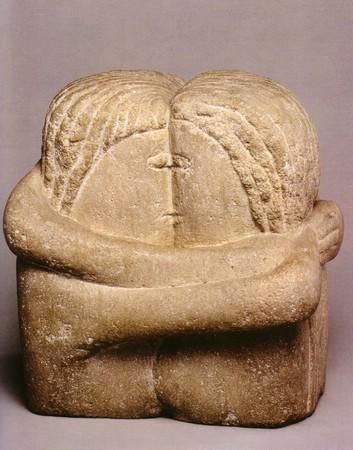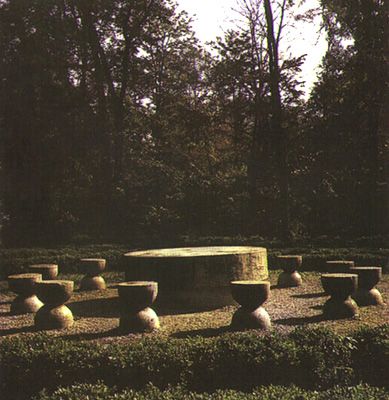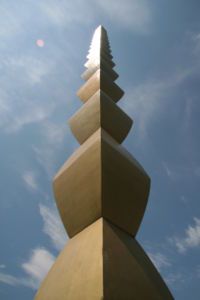According to most art critics and collectors, Constantin Brancusi is the greatest Romanian artist ever, well renowned all around the world as an enigmatic, highly original and profoundly personal sculptor, whose works have been presented, commented, attacked and adulated, considered to the the works of a genius, always winning high prizes at art auctions.
 | Brancusi was born on February 19th 1876 in the small village of Hobita, where he grew up, in a modest family. He discovered art by studying from his early years the works of traditional folk art, and it wasn't long before he began making his own small wooden carvings and sculptures. He would eventually leave his village, fed up with the poor and hard life, settling at 13 in Craiova, where he worked in a small grocery shop, for some years. Despite that, he kept carving in his sapre time, using both traditional motifs and themes, as well as original ones. When he was 18, with the help of his employer, he managed to enroll at the local School of Crafts, which he would eventually graduate, already a rather mature and impressive artist, in 1898. |
Wanting to perfect his training, Brancusi then enrolled at the Fine Arts School in Bucharest, where he studied sculpture and in a short while he had proven to be not only very talented, but also really hard working. Only a few of his early works survived, among them a striking ecorche, a classical and rather macabre theme, treated in a classical manner that was so much unlike the later Brancusi. Starting with 1903, Brancusi left for Munich, then to Paris. The Parisian experience will forever change and influence him, as he became a member and close friend of the avantgarde circles, worked in the studio of Antonin Mercie and even met and worked with Rodin. Yet, despite his love and admiration for Rodin, Brancusi was too much of a rebel and independent artist, so he left the French artist in just two months.

image :
Table of silence by Constantin Brancusi, Targu Jiu city, Romania
It was after this so-called breakup that he began working in his unique, personal style, trying to capture the very essence of the works, and the results were astounding. Moreover, he began carving almost exclusivelly, a hard and strenous technique, that further emphasised the unicity of his designs. Brancusi would produce a series of important works, some of them having several versions : The Prayer, Sleeping Muse, The Kiss. It wasn't long that he became popular in Romania, France and the USA, and in 1913 he exhibited at the Salon des Independants and the Armory Show, the famous American exhibition. He was close to Pablo Picasso, Guillaum Apollinaire, Marcel Duchamp, Henri Rousseau, just to name a few, his works were coveted by collectors.
By 1920, his style was already defined, but it was so unique and strange that sometimes his works were rejected from shows or at least caused a great degree of controversy. He was not only a sculptor, but also a musician, handyman, worker, a well-read and curios person, who liked to to talk about art and science, at the same time liking to work with his hands. Highly popular in the US, where he would return several times, he spent a lot of his time in Paris, and in 1933 he even received a strange commision : the design for a temple in India, a project that ultimately fell through. |  |
It was in 1938 that Constantin Brancusi finally finished his most important work, a World War I monumentum in Targu-Jiu, made out of the Table of Silence, Gate of the Kiss and Endless Column, enigmatic large scale works, nowadays famous world-wide. It was the height of his career, for the last part of his life Brancusi working in a much more relaxed manner. He prefered the retreat of his Parisian studio, far away from his native country, and became a French citizen in 1952. In his latter years he enthusiasticaly discovered photography, and upon his death, on March 16th 1957, he left behind around 1200 photographs and 215 sculptures. The studio of the artist and all of the works were donated to the Musee National d'Art Moderne in Paris, one of Brancusi's last wishes.
Today, his unique and highly valuable works can be found in some of the best museums all around the world or in prestigious private collections, as the price for a Brancusi sculpture is going up day by day. It is rare for art collectors to find one of these at auctions, and when they do, the prices simply go crazy. Constantin Brancusi is not only one of the great masters of the 20th century art, but also an enigma. How did he create his unique and so simple, yet so profound style ? Which were the influences, themes, artists that left their mark on him ? What exactly did he want to express through his works ?
Photo : wikipedia.org

































